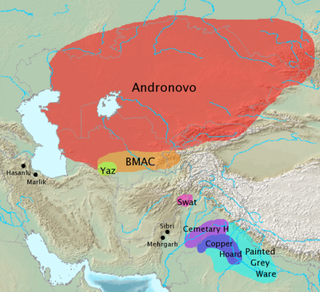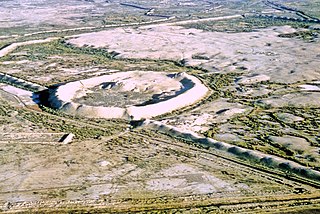The Chalcolithic is an archaeological period characterized by the increasing use of smelted copper. It follows the Neolithic and precedes the Bronze Age. It occurs at different periods in different areas, and is absent in some parts of the world, such as Russia. Stone tools were still predominantly used during this period.

The Bactria–Margiana Archaeological Complex (BMAC) is the modern archaeological designation for a particular Middle Bronze Age civilization of southern Central Asia also known as the Oxus Civilization. The civilization's urban phase or Integration Era, was dated in 2010 by Sandro Salvatori to c. 2400–1950 BC, but a different view is held by Nadezhda A. Duvoba and Bertille Lyonnet, c. 2250–1700 BC.
Tepe Sialk is a large ancient archeological site in a suburb of the city of Kashan, Isfahan Province, in central Iran, close to Fin Garden. The culture that inhabited this area has been linked to the Zayandeh River Culture.

The Yaz culture was an early Iron Age culture of Margiana, Bactria and Sogdia. It emerges at the top of late Bronze Age sites (BMAC), sometimes as mud-brick platforms and sizeable houses associated with irrigation systems. Ceramics were mostly hand-made, but there was increasing use of wheel-thrown ware. There have been found bronze or iron arrowheads, also iron sickles or carpet knives among other artifacts.

Teppe Zagheh is an early urban settlement located near Qazvin, Iran. In Persian, Tappeh means "tell, mound". It was first excavated by a team from the University of Tehran under the direction of Ezzat Negahban in the early 1970s
Namazga-Tepe or Namazga-depe, is a Bronze Age (BMAC) archaeological site in Turkmenistan, some 100 km east of Aşgabat, near the border to Iran. Excavated by Vadim Mikhailovich Masson, Viktor Sarianidi, and I. N. Khlopin from the 1950s, the site set the chronology for the Bronze Age sites in Turkmenistan.

Altyndepe, is a Bronze Age (BMAC) archaeological site in Turkmenistan, near Aşgabat, inhabited first from c. 3200 to 2400 BCE in the Late Regionalization Era, and from c. 2400 to 2000 BCE in the Integration Era as a full urban site.
Tapeh Yahya is an archaeological site in Kermān Province, Iran, some 220 kilometres (140 mi) south of Kerman city, 90 kilometres (56 mi) south of Baft city and 90 km south-west of Jiroft. The easternmost occupation of the Proto-Elamite culture was found there.
Jajarm is a city in, and the capital of, the Central District of Jajarm County, North Khorasan province, Iran, and also serves as capital of the county.
Ulug Depe is an ancient Bronze Age site in the foothills of the Kopet Dag Mountains in the Karakum Desert of Kaka District (Kaahka) in the Ahal Province of south-eastern Turkmenistan. It covers around 13 hectares and lies on a mound at a height of about 30 meters, displaying the longest stratigraphic sequence of Central Asia, from the Late Neolithic, represented by Jeitun culture, until the pre-Achaemenid period.

The list of Turkmenistan-related articles is below
Tureng Tepe is a Neolithic and Chalcolithic archaeological site in northeastern Iran, in the Gorgan plain, approximately 17 km northeast of the town of Gorgan. Nearby is a village of Turang Tappeh.

Cheshmeh-Ali is an ancient recreational place, located in the south of Tehran and north of Rey or Ray in the country of Iran. The spring is spot in the neighborhood of Ebn-e Babooyeh, Tughrul Tower, and below the Rashkan castle and next to Rey Castle and Fath Ali shah inscription. In the past, carpet sellers and people used to wash their carpets there, with their idea that the property of this spring water is good and clean for carpets and make them full lighter color by its mineral water.
Shir Ashian Tepe is a prehistoric archaeological site in the Semnan Province of Iran, situated in Shir Ashian, about 15 kilometres southwest of Damghan.

The South Turkmenistan Complex Archaeological Expedition (STACE), also called the South Turkmenistan Archaeological Inter-disciplinary Expedition of the Academy of Sciences of the Turkmen Soviet Socialist Republic (YuTAKE) was endorsed by the Turkmenistan Academy of Sciences. It was initially organized by the orientalist Mikhail Evgenievich Masson in 1946. The expedition had several excavations or "Brigades", based on sites and periods, and were spread over many years.

Jeitun (Djeitun) is an archaeological site of the Neolithic period in southern Turkmenistan, about 30 kilometers north of Ashgabat in the Kopet-Dag mountain range. The settlement was occupied from about 7200 to 4500 BC possibly with short interruptions. Jeitun has given its name to the whole Neolithic period in the foothills of the Kopet Dag.

Sang-i Chakmak is a Neolithic archaeological site located about 1 km (0.62 mi) north of the village of Bastam in the northern Semnan Province of Iran, on the southeastern flank of the Elburs Mountains. The site represents quite well the transition from the aceramic Neolithic phase in the general area; this was taking place during the 7th millennium BC.
Yarim Tepe is a Neolithic settlement in the eastern Gorgan plain, Golestan Province. It is located near Gonbad-e Kavus. This ancient settlement played a big role in establishing the cultural chronology of the neolithic period in Central Asia.
Togolok is an archaeological site in the Murghab Delta, Turkmenistan, located about 10–15 km south of Gonur. Togolok 21 is an Indo-Iranian temple and fortress dated to the first half of the 2nd millennium BC, belonging to the late phase of the Bactria–Margiana Archaeological Complex (BMAC). Togolok 1 area has also been excavated.

Monjukli Depe is an ancient settlement in south Turkmenistan, at the northern edge of the Kopet Dag mountains. Excavations reveal occupation from the late Neolithic period, starting about 6200 BC, to the early Chalcolithic period. The earliest layers belong to the Jeitun culture of Turkmenistan.










